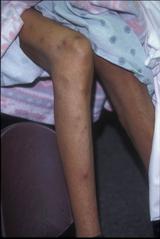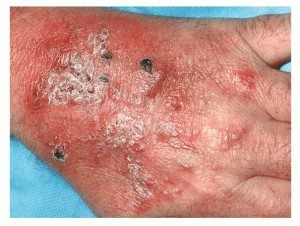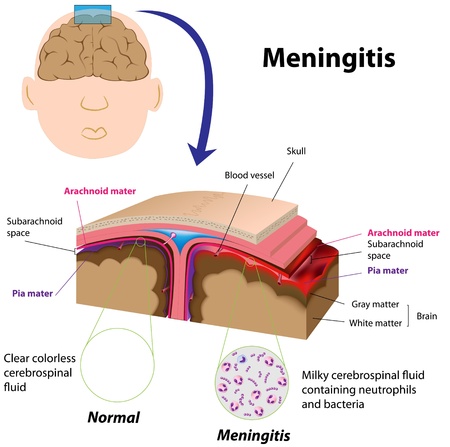Nocardiosis Definition
Page Contents
It is a rare infectious disorder which affects the lungs or the entire body. Bacterium from the genus Nocardia, especially Nocardia asteroides and Nocardia brasiliensis, is mainly responsible for the occurrence of this condition. Individuals with a weakened immunity due to some health problem are more at risk of developing this bacterial infection.
The condition is also found to affect cats, dogs, birds, fishes and cattle.
Nocardiosis Causes
The Nocardia spp is found in soil and enters the human body mainly through breathing. The bacteria initially lead to pneumonia, which may cause sepsis or blood poisoning. In this way, the infection may gradually spread to other areas of the body such as skin and brain. The condition is referred to as disseminated Nocardiosis when it occurs in this manner.
Sometimes, the infection may be introduced through a skin lesion, puncture, cut or wound that may occur while working outdoors. This type of skin infection can take various forms and is known as Cutaneous Nocardiosis. Individuals with occupations or hobbies that involve exposure to soil, such as farming, gardening, landscaping and other field works, are more at risk of being affected by this infection.
The disorder has various other risk factors, which include:
- Alcoholism
- Bone marrow/stem cell transplantation
- Ulcerative colitis
- Renal failure
- Renal transplantation
- HIV infection
- Long-term use of corticosteroids
Nocardiosis Signs and Symptoms
This infectious disease can affect various parts of the human body including the skin, brain and lungs. However, it is not contagious. The infection has been classified into several categories, such as the Pulmonary Nocardiosis (affecting the lungs) and Systemic Nocardiosis (affecting the whole body).
The symptoms may vary depending on the location of the infection.
Entire Body Symptoms
- Recurring fever
- Malaise or general uneasiness or discomfort
- Night sweats
Lung Symptoms
- Breathing difficulty
- Cough with mucus
- Rapid breathing
- Chest pain which not related to any heart problems
- Shortness of breath
- Coughing up blood
Brain Symptoms
- Fever
- Seizures
- Headache
- Cerebral abscesses
Gastrointestinal System Symptoms
- Nausea
- Unexplained weight loss
- Hepatosplenomegaly or swelling of the liver and spleen
- Vomiting
Skin Symptoms
- Skin lumps or rashes
- Abscesses or skin sores
- Swollen lymph nodes
Nervous System Symptoms
- Confusion
- Headache
- Dizziness
- Seizures
- Changes in mental state
Muscle and Joint Symptoms
- Joint pain
In some rare cases, the infectious disorder can affect the eyes and lead to certain ocular manifestations such as keratitis and ocular trauma.
Nocardiosis Prevention
Prevention may be difficult in susceptible individuals. However, taking some preventive measures can decrease their risk of developing the disease. They should avoid working outdoors without protection. Wearing gloves and socks can prevent the skin from coming into direct contact with the soil. This measure should also be adopted by healthy individuals to avoid the disorder.
Taking Trimethoprim or sulfamethoxazole prophylaxis during the first six months after undergoing organ transplantation can help to prevent the condition.
Nocardiosis Diagnosis
Various diagnostic tests are used for detecting this infection. The Nocardia bacteria are visible on the gram stain. The diagnosis varies according to the site of infection as the symptoms are different for various locations. The following tests can be used for making the diagnosis:
- Brain biopsy
- Sputum culture
- Bronchoscopy
- Skin biopsy
- Lung biopsy
- Chest x-ray
- CT scan
- Pleural fluid stain and culture
Nocardiosis Differential Diagnosis
The differential diagnoses include the following:
- Actinomycosis
- Tuberculosis
- Aspergillosis
- Pleuropulmonary Empyema
- Sporotrichosis
- Cellulitis
- Kaposi Sarcoma
- Lung Abscess
- Glioblastoma Multiforme
- Histoplasmosis
Nocardiosis Treatment
It is generally treated with antibiotic medications (usually sulfonamides). Acute phases of the condition require long bed-rest. The treatment continues for 6 months to 1 year depending on the severity of the infection and the involved body parts. The treatment may last longer in serious cases of the disease. Chronic suppressive therapy or low-dose, long-term antibiotic therapy is often required to cure the disorder. Penicillin is not used in this treatment as the Nocardia bacteria are penicillin-resistant. Sulfamethoxazole-trimethoprim (Bactrim) is most commonly used for treating Nocardiosis.
Sometimes, surgical intervention may be required for draining or removing the abscesses caused by the infection. Surgery may also be performed for removing diseased tissues.
Nocardiosis Prognosis
The outcome is positive with early diagnosis and prompt treatment. The time for recovery usually ranges between 12 months and 18 months. However, the prognosis may be poor if the infection spreads in a wide area outside the lungs. Delay in treatment and having some serious underlying disorder can also make the outcome poor. This infectious disease is associated with a high mortality rate between 50% and 80%. Studies show the death rate to be higher when the infection affects the brain.
Nocardiosis Complications
In around 25% of all cases, the disorder advances into a serious brain condition named Encephalitis. Other complications that can arise from delayed treatment of the condition or leaving it untreated include brain abscesses and serious skin infection.
Nocardiosis Incidence
Statistics shows that around 500 to 1000 individuals are affected by the disease every year in the United States. This number is increasing gradually over time.
Nocardiosis Pictures
The following pictures show how the Nocardia bacteria affect various parts of the body.
Picture 1 – Nocardiosis
Picture 2 – Nocardiosis Image
Nocardiosis is a potentially life threatening bacterial infection which requires early diagnosis and proper treatment in order to save the patient’s life. It has a very high fatality rate even with proper management. However, many patients recover from the disease on receiving antibiotic treatment.
References:
http://health.nytimes.com/health/guides/disease/nocardia-infection/overview.html
http://emedicine.medscape.com/article/224123-treatment
http://www.umm.edu/ency/article/000083all.htm



